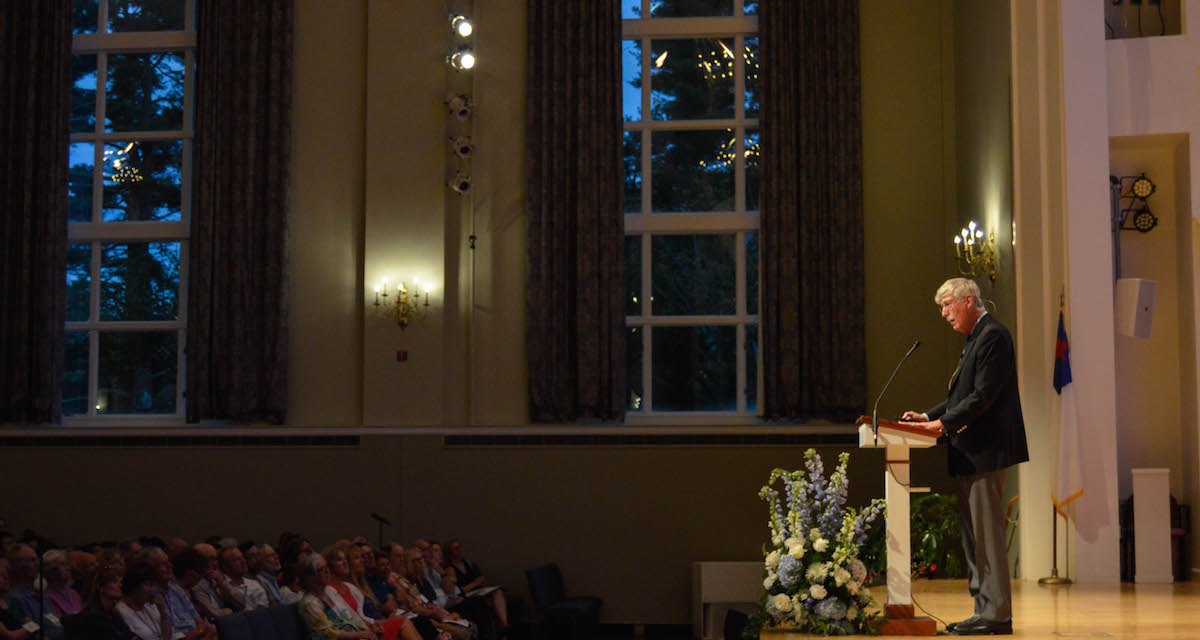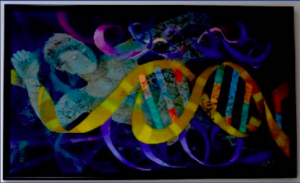Exploring the future of gene editing with Dr. Francis Collins
Last weekend, Gordon hosted 360 Christians in the sciences for American Scientific Affiliation’s (ASA) annual conference as they explored existing and emerging tensions between bioethics and biotechnology. On Saturday, July 28, ASA invited the greater Gordon community in the Boston area to hear from one of their speakers and members, Dr. Francis Collins, the physician-geneticist known for leading the Human Genome Project, directing the National Institute of Health (NIH), authoring New York Times bestseller The Language of God: A Scientist Presents Evidence for Belief and starting The BioLogos Foundation.
During his public lecture “The Joyful Complementarity of Science and Faith,” Collins celebrated the complementary nature of the two by examining how well they stand together in the face of a recent scientific controversy—namely, a gene editing technology called CRISPR/Cas9 which has the power to fundamentally change the human genome.
“Science and our view of what it means to be human are coming into an interesting space,” said Collins. “How should believers view advances in gene editing? Together we can think about the appropriate way to take this scientific opportunity and make sure we’re using it in a fashion that would honor what it means to be fearfully and wonderfully made.”
What CRISPR/Cas9 has to offer to those living with genetic diseases
But to appropriately answer this question, Collins revisited the problem for which CRISPR/Cas9 is a real solution for—the 6,000-plus genetic diseases that exist today, most of which are severely debilitating, fatal and without treatment.
Back in the 1980s, Collins became very familiar with one of these genetic diseases: cystic fibrosis (CF). At the University of Michigan, he was on a research team of “gene hunters” whose sole purpose was to identify the disease gene causing CF. To do so, they had to “sift through three billion base-layers of the human genome to find one letter that was out of place.”
In 1989, his team finally pinpointed the disease gene for CF, but Collins was discouraged. This was an awfully slow way to tackle some of the world’s most difficult diseases.
It wasn’t until a few years ago that geneticists could actually provide a scalable solution for the thousands of other genetic diseases known to humankind. Collins explained in the latter half of his lecture that thanks to a pair of “DNA-scissors” called CRISPR/Cas9, scientists can now replace bad genes with good ones.
How we can move forward now that gene editing is possible
Although CRISPR/Cas9 has given humans the ability to virtually erase every genetic disease from the planet and the ability to instruct immune cells to attack cancer without the need for chemotherapy or radiation, Collins cautioned that the line between treatment and enhancement can be hard to define.
Even with so many grey areas, Collins mentioned that—given the progress involving infants living with spina bifida and people living with sickle cell anemia and many others suffering from genetic diseases— “doing nothing is the most unethical of the options.”
Yet as CRISPR/Cas9 continues to get more sophisticated and gene editing starts to skirt and trespass over several ethical boundaries, Collins urged, “we must proceed, but proceed responsibly.”
To provide guidance on how to move forward when thinking about advances in biotechnology, Collins urged Christians and scientists who are believers to consult the two books God has authored.
“We are given the privilege as scientists who are Christians to read both of Gods books—as Sir Francis Bacon puts it—the book of God’s words (the Bible) and the book of God’s works (nature). If we believe that God is the author of both then how could they be in conflict?” asked Collins. If we do see a conflict between science and faith, then “surely we are the ones who have misunderstood.”
In closing, Collins provided a metaphor and a visual for how Christians and scientists who are believers can move forward responsibly—in stewardship of Imago Dei, the image of God.
“This is a portrait that hangs over my desk in my office at NIH. The title of this painting is Jacob’s Ladder. . . the ladder is a double helix with angels going up and down on it,” said Collins. I think this is a nice metaphor for what we’re trying to do as scientists who are believers—to bring together the awesome things that are being discovered in science and remember really what it’s all about. Jesus spent a lot of his time healing people, and I think we are called to do that to. But we have to do so in a fashion that represents and adequately stands up for all those principles we were also given as human beings, especially as human beings who have the image of God in them.”
To find out more about the ASA, contact Gordon alumna Vicki Best, ASA Director of Operations and Development, at [email protected] or consider joining ASA’s student chapter by contacting Dr. Mike Paul at [email protected]
Photo courtesy of Zach Enfield
 The Bell
The Bell
